Home » Other Articles » Tuesday Treasures Index » Tuesday Treasures - September 2023 - Tuesday Treasures - September 2023
Tuesday Treasures - September 2023
TUESDAY 26 SEPTEMBER
Station Name Boards
Passengers on today’s railway suffer from a barrage of repetitive and mostly unnecessary information. In fact a quiet journey on a modern train is a virtual impossibility. In times past the travelling public had to rely on their own alertness and awareness of where they were and be ready to disembark at the appropriate point.

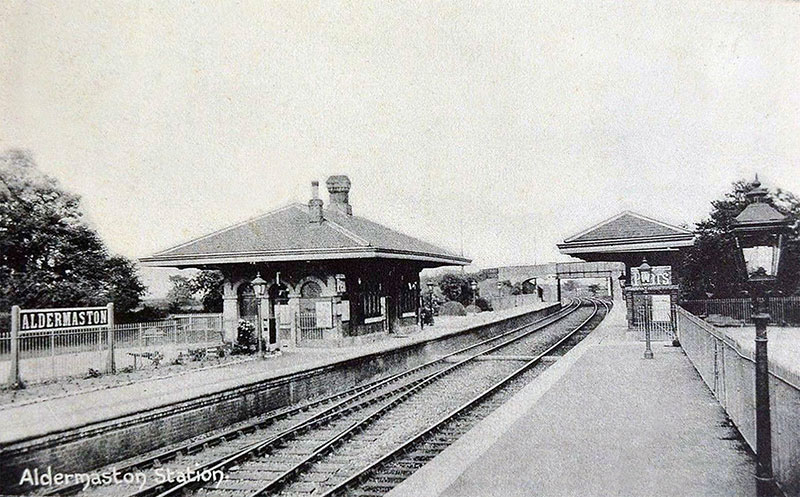
Aldermaston station showing one of the cast iron name boards
To assist passengers, large station name boards were erected at the approach end of each platform. They were large, heavy items, at least 5ft long and mounted on posts such that they were about 6ft high. Over the years, they were produced in different styles – enamel on steel, cast letters on a wooden back board or in solid cast iron as seen here.


Taplow station on 25 July 1953 with No 5983 Henley Hall passing one of the cast iron name boards. Photograph by Ben Brooksbank
The Great Western Trust has a number of examples in its collection including WHEATLEY from the Thame branch, TAPLOW on the original GWR main line just east of Maidenhead Bridge and ALDERMASTON (very heavy) on the Berks & Hants line between Reading and Newbury.


Wheatley station in 1959. Photograph by Lamberhurst, Creative Commons
Aided by a ‘call’ from the station porter these name boards meant you could be very sure of your location. A very few are still extant on Network Rail today, most notably at Charlbury (cast iron letters on wood) and Pewsey (solid cast iron). Long may they continue in use.
TUESDAY 19 SEPTEMBER
Swindon Works under Churchward as CME
Students of locomotive design evolution and the Great Western Railway’s activities and products in that crucial sphere are probably well aware that Churchward when Chief Mechanical Engineer was enthusiastically supportive and active in gaining constant awareness of contemporary developments. This is most obviously demonstrated by his convincing the GWR directors for him to purchase from France, not one but three compound locos. However today’s blog demonstrates that looking to Europe was only one direction of his gaze, as the USA was very important to him too.
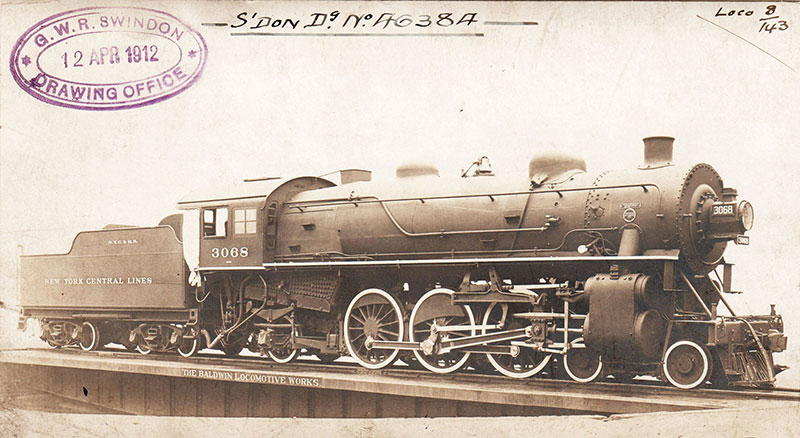
From the Great Western Trust collection we illustrate this official publication photo card by the Baldwin Locomotive Works Company of the USA, of their recently built Pacific loco No 3068 for the New York & Hudson Railroad Co Class K-11-C. The reverse side provides all the important technical and dimensional information a potential railroad customer might seek, and there it adds that the locomotive is fitted with a Schmidt superheater.
Well, as the image clearly shows, this was received into the GWR Swindon Drawing Office records on 12 April 1912 being sufficiently important to be placed in their records files for future reference we assume.
Around that period, Churchward had already chosen his family of standard locomotives for the needs of the GWR and production in quantity was progressing. We also know that some of his ‘bright young men’ within his design and drawing office team, had already been to the USA and Canada to seek out contemporary information, not least on the actual in-traffic performance of many new designs.
It was just one such example of Holcroft who had recently visited Canada and was impressed by the in traffic exploits of their Mogul 2-6-0s – a type that Churchward had previously excluded from his ‘standard family’. Well Holcroft was convincing and we must be very grateful to him for our GWS DRC mogul No 5322 which together with our 0-6-0 saddle tank No 1363 form our ‘original‘ Churchward products, with 2999 being our modern homage to his Saint class, sadly ignored by those in power who chose the locos for the National Collection back in the early 1950s.
Returning to our photo, we should note that in ink added to the top is “S’Don Dg No 46384” and “Loco 8/143”. We think that the latter is the Drawing Office card index reference number. But crucially, what is the relevance of that Swindon drawing number? We know that a close number 46322 of April 1912 no less related to Churchward and the GWR’s only Pacific No.111 The Great Bear, its trailing axle box so could our 46384 link this Baldwin Pacific with No.111, possibly its firebox?
The mystery continues ….
TUESDAY 12 SEPTEMBER
Delivering the Goods – Part 5
Our previous blogs on this broad but vital subject have explored the actual traffics and trains etc. Today we turn to the impact upon the GWR and its future BRWR successor, of their liability if that ‘transit’ goes wrong.
We illustrate from the Great Western Trust collection a short but clearly very urgent and ‘Important’ notice of 19 September 1893, from the Chief Goods Manager, one J L Wilkinson, to all staff regarding ‘COLERIDGE’S CLAIM – £1,000’.

130 years ago, such a call upon staff (or the Company Servants) was not to be dismissed lightly by anyone. £1,000 then is roughly £105,000 today, so the GWR was exposed to a serious liability if the hamper wasn’t found, and this was beyond the enormous reputational damage they would receive by the loss in their care of what was such important literary material.

Coleridge 1772-1834 was an English poet and joint founder with Wordsworth of the Romantic Movement and was famed for his Rime of the Ancient Mariner. He wrote the poem while living at Nether Stowey, near Bridgwater, from 1797 to 1799. He also wrote Kubla Khan at the same time. The first photograph shows the house where he lived at Nether Stowey, while it was trading as ‘Moore’s Coleridge Cottage Inn’ about 1890. It is the building on the left, with the people outside. The second photograph of the cottage, by then owned by the National Trust, was published in the Great Western Railway Magazine, December 1940 edition.
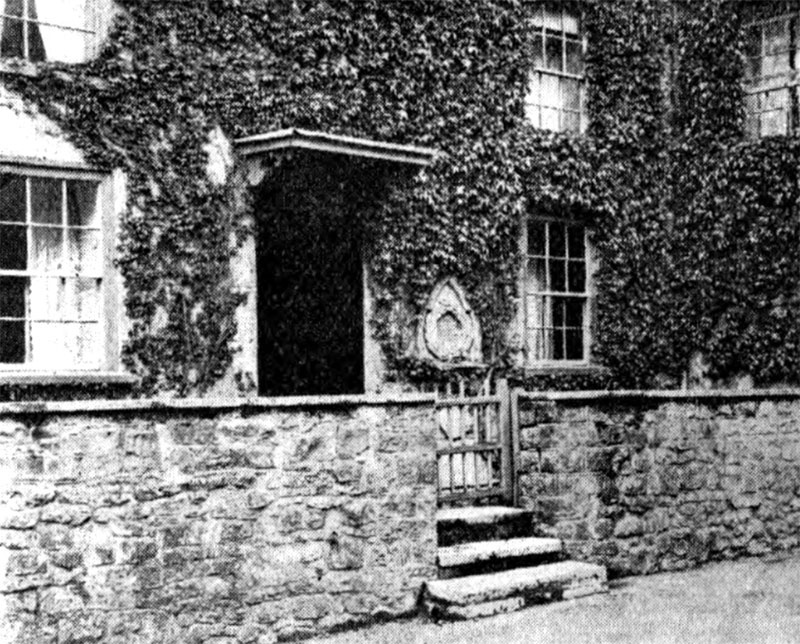
From the great descriptive detail in the Trust’s notice, it could well be the fear was that, having a padlock, brought its potential value to an opportunistic thief?
Like so many ephemeral items like this notice, we have no further GWR records of how this played out, but the papers were found as they still do exist today, and are in an archive.
A two-volume tome The Letters of Samuel Taylor Coleridge was published by Heinemann in April 1895. This work was edited by Ernest Hartley Coleridge, the grandson of Samuel Taylor. As Ernest lived at Weybridge we can deduce he was the sender of the missing hamper.
This item alone stands out because of the Coleridge name, his fame and the importance of those original documents to our heritage, let alone the eye-watering financial claim they created. However, our collection holds numerous similar ‘search for’ instructions, many indeed for ‘mislaid’ GWR or private owner wagons!!
Delivering the goods, wasn’t a simple or risk-free business, as we sadly personally experience even today when ordered items fail to arrive!
TUESDAY 5 SEPTEMBER
A Special Excursion
Today we look back to September 1957 to illustrate and reflect upon a handbill, which is just one of thousands we hold in our Great Western Trust collection.
Published in July, it informs us that on Sunday September 15, a Special Limited Excursion hauled by City of Truro locomotive will run between Plymouth (North Road) and Penzance calling at Saltash in both directions, all for 13 shillings and 6 pence (67½ p in today’s currency, £13.20 at today’s value) second class.

Perhaps most striking to our eyes is that BRWR use the clarion call heading of: ‘Calling All Railway Enthusiasts!’
Perhaps we shouldn’t be surprised after all, in that the then BRWR General Manager was one K W C Grand, a long-standing officer of the Great Western Railway, who clearly supported and maintained the GWR long-standing tradition of positively engaging with the Railway Enthusiast community, which sadly in the succeeding years of perhaps over-rapid dieselisation of the Western Region became unfashionable, and to a great extent avoided altogether.
It is, we believe, important that the Trust collection preserves and interprets material items such as this modest handbill, to prove the manner in which for a number of years post-Nationalisation, BRWR officers maintained the GWR traditions.
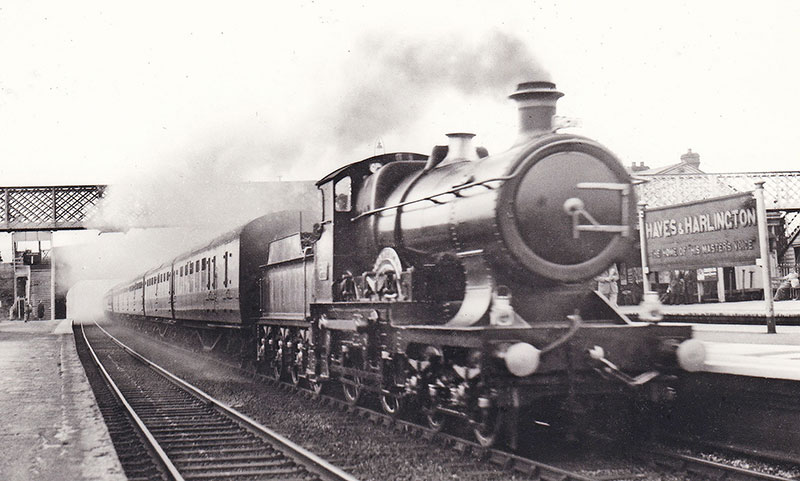
No 3440 heads a return RCTS excursion from Swindon to Paddington through Hayes and Harlington on 18 August 1957. Photograph from the LCGB Ken Nunn collection
A report of the excursion was published in Railway Observer (RO), magazine of the Railway Correspondence and Travel Society (RCTS). These magazines are also available in the Trust’s reference library at Didcot. Being written for railway enthusiasts the RO report may in places appear to many readers that it it written in a foreign language, so we have decoded some of the more mysterious references
CITY OF TRURO
An excursion from Plymouth to Penzance on 15th September was honoured with City of Truro, making what is believed to be its first visit to its name town. (The writer has not found any record of 6ft.·8½ in.(1) 4-4-0s working west of Plymouth, though three Atbaras(2) and/or Badmintons(2) are said to have done so). The six-coach train, formed of a collection of three L.M.S. and three G.W. coaches well-mixed, with a Scottish allocated Fowler wooden compo(3) brake leading,·tared(4) 185 tons and was well filled.
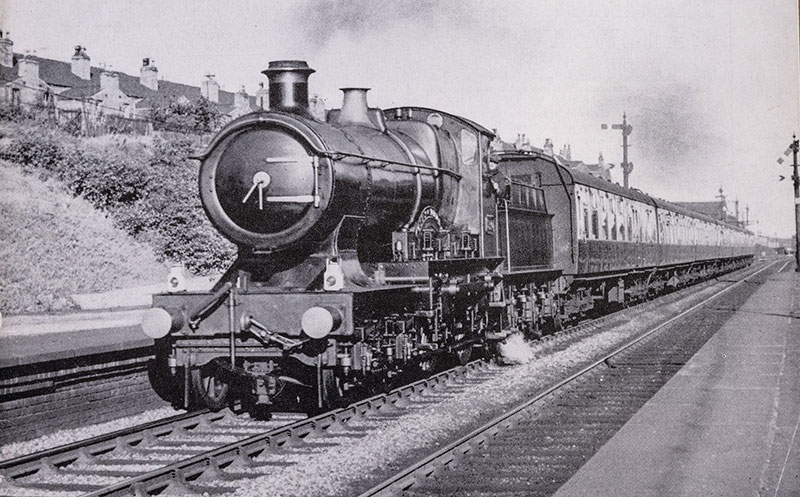
No 3440 heads a Stephenson Locomotive Society excursion through Small Heath and Sparkbrook station, Birmingham, on 16 June 1958. Photograph by Michael Mensing, published on the front cover of Railway World, September 1958 edition
The load was limited so that 3440 could run unassisted. The booked starting time was 9.10 a.m. arriving Penzance 11.55. 3440 left North Road four minutes late, but, with the very generous schedule, Saltash (the first stop) was left on time at 9.25, and, in spite of several p.w. slacks(5), Truro was reached two minutes early at 10.48. Here ten minutes were allowed, and taken, for watering and engine-worship.
The schedule, based on the weekday 9.10 – which has more stops – was then improved on to such purpose that seven minutes had to be added to an already-lengthy ticket-collecting stop at St. Erth, and arrival at Penzance was still four minutes early.
The return excursion left at 5.30 p.m. and was given five minutes less, being due at Plymouth at 8.10. Saltash was reached well ahead of time and left one minute early (7.54), and, despite extra stops at St. Budeaux and Keyham arrival at North Road(6) was three minutes early.
City of Truro had been worked to Laira(7) from Didcot for the special train as train engine(8) on the 5.30 a.m. ex-Paddington on 12th September. The ‘pilot’(8) was the King(9) normally on this duty.
- 6 ft 8½ in driving wheel diameter, the standard for GWR express passenger locomotives.
- Two classes of 4-4-0s which also shared 6 ft 8½ in driving wheels.
- Compo is an abbreviation of composite, meaning 1st and 2nd class passenger accommodation.
- Tare is the weight of the train’s vehicles empty of passengers.
- P W slacks are speed reductions because of engineering work on the permanent way (track).
- Plymouth (North Road) station.
- Laira is the engine shed at Plymouth.
- City of Truro was allocated to Didcot shed, so coupling her at the front of the train from Paddington when it stopped at Didcot was an economical method of getting her to Plymouth. It was GWR practice, when a train was double-headed, for the ‘pilot’, or assisting, engine to be coupled behind the train engine. So it appears City of Truro had the honour of leading the train on this occasion.
- A King class 4-6-0 locomotive.
Didcot Railway Centre Newsletter
Stay up to date with events and what's going on at Didcot Railway Centre.
You may unsubscribe at any time. We do not share your data with 3rd parties.